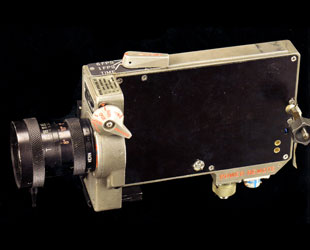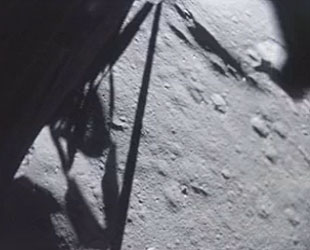July 4, 2011 — If the government throws a camera away on the moon and an astronaut then picks it up and saves it, does it become his to own and sell?
That's more or less the question the U.S. government is seeking a federal court answer in the case "United States of America vs. Edgar Mitchell," which was filed in Miami last Wednesday.
The lawsuit, which names the sixth man to walk on the moon as the defendant, asks the court to declare a movie camera that was used during the 1971 Apollo 14 mission as the "exclusive property of the United States."
After returning to Earth with the camera and having it in his possession for the past four decades, Mitchell, 80, attempted to sell it last month through a New York auction house. The camera, which was estimated to sell between $60,000 and $80,000, was withdrawn before its sale could proceed.
According to the lawsuit, which was filed by Asst. U.S. Attorney Christopher Macchiaroli on behalf of NASA, the government made "multiple requests" for Mitchell to return the camera "and no response [was] provided."
From the moon to the Earth
To understand why the camera's ownership is now being contested, one must first appreciate how it ended up back on Earth.

A multi-speed camera, it could be used to take single photos or capture a series of frames. (Bonhams) |
The 6-inch long by 4-inch high by 2-inch thick (15 by 10 by 5 cm) Data Acquisition Camera (DAC) was one of two 16 mm motion picture cameras aboard the Apollo 14 lunar module "Antares" when it landed on the moon on Feb, 5, 1971. Used to record engineering data, terrain and lunar surface photography, this particular camera was mounted inside, looking out the right window on Mitchell's side of the lander.
The camera shot the final five minutes of Antares' landing, as Mitchell's crewmate, commander Alan Shepard, piloted the spacecraft to a touchdown on the moon's Fra Mauro Highlands.
After more than 33 hours on the surface, including two moon walks and a couple of swings with a makeshift golf club, Shepard and Mitchell blasted off the moon with the camera still on board.
The mission plan called for the DAC to be left in Antares to save weight aboard the command module "Kitty Hawk," the capsule that would return the astronauts' to Earth. The lunar module and all its contents would be left to slam back onto the moon just a day later.

The view of the lunar surface as filmed by the Data Acquisition Camera aboard the Apollo 14 lunar module Antares. (NASA) |
Mitchell however, had other plans. In addition to various other spacesuit and spacecraft hardware that Shepard and he saved from being smashed to smithereens, Mitchell moved the camera to the command module for the ride home.
"In addition to taking the data out of it, the tape, I brought the camera itself back too," Mitchell told WPTV, the NBC-Affiliate near his home in Palm Beach, Florida.
Mission mementos
The Apollo 14 astronauts were not the only crewmates to salvage parts of their lunar module as mementos. Almost all the others did the same.
The Apollo 13 crew was instructed by Mission Control to salvage spare parts from their moon lander. A mid-flight explosion famously ended in their landing being canceled, and their module's mementos helped compensate for the missing weight that was to have been made up by moon rocks.
But a problem was not necessary for others to bring home unplanned souvenirs.
Astronauts aboard Apollo 12 and Apollo 15 ripped off parts of their moonwalking suits' life support backpacks before they were discarded onto the lunar surface. Others saved their module's joystick hand controllers, as well as netting used to restrain equipment and support cables.
NASA didn't need these make-shift mementos to return to Earth. In some cases, such as the camera brought back by Mitchell, the agency's plan was to have it deposited at the bottom of an impact crater created when the lander it was stowed on re-rendezvoused with the moon's surface.
Just the same, the astronauts asked their bosses at the Manned Spacecraft Center — now Johnson Space Center — in Houston, Texas for permission to keep the items they returned, along with other souvenirs such as their personal hygiene kits and the checklists they followed to navigate to and from the moon.
"We had an agreement with NASA management, that small items that didn't exceed our weight limitations, we could bring back," Mitchell told WPTV.
A few memos reside today in the NASA history archives describing some of the types of items that the astronauts desired and could keep, but no formal property transfer was apparently drafted. A September 1972 interview with Donald "Deke" Slayton, head of NASA's astronaut corps at the time of Apollo 14, states that an inventory of every spacecraft part to be returned as a memento was created ahead of the mission launching.
"They give me a list of things they're going to bring back," Slayton, who died in 1993, told the Tucson Daily Citizen. "I give it to the program office and they bring 'em back."
Anything registered on the list was considered "legal" for the astronauts to keep, but Slayton insisted on restricting the list to the astronauts' eyes only. "It's the astronauts' personal business," he told the newspaper.
Of course at the time, the mementos were just that: items placed on the mantle and in some cases, loaned by the astronauts to museums. No one considered the financial value of the flown-to-the-moon artifacts.
Can't take it with you
Forty years later, the Apollo astronauts are now long since retired and have found collectors interested in their moon mementos. Dedicated auctions for space artifacts began in the early 90's and many of the moonwalkers have been selling their flown souvenirs over the past two decades.
So it wasn't that unusual that, together with others of his moonwalking colleagues, Mitchell consigned some of his memorabilia to Bonhams auction house in New York for their May 5, 2011 "Space History Sale."

Apollo 14 astronaut Edgar Mitchell seen at the Astronaut Hall of Fame induction ceremony held on May 7, 2011. (collectSPACE) |
In addition to the DAC, Mitchell offered up two Apollo 14 flown American flags, a tissue dispenser from Kitty Hawk and a strap from his spacesuit's life support backpack. The flags sold for more than $8,500 and $20,000 each. The tissue box and backpack strap went unsold.
Only the camera was withdrawn at the request of the U.S. government.
"Without authorization or right of title, Defendant [Mitchell] is improperly maintaining dominion over the NASA camera and is attempting to sell it to a third-party via an auction undertaken by Bonhams, a privately owned British auction house," the lawsuit alleges.
It is unclear what distinguishes the DAC from other moon mementos the government allowed the astronauts to keep and sell. The U.S. Attorney's complaint only states that Mitchell "failed to provide any evidence establishing his legal right to the NASA camera."
Mitchell has said in recent media interviews that he knew the government had concerns but thought that it had since been resolved.
Good, clean, and exclusive title
The government's desired resolution is defined in the court papers.
"Declare that the United States has good, clean, and exclusive title to the NASA camera identified herein; declare that the Defendant has no legal rights or title in the NASA camera identified herein; require Defendant to immediately produce to the United States or the Clerk of the Court the NASA camera identified herein."
The government is also seeking Mitchell to be responsible for paying the fees and costs associated with the lawsuit.
For his part, Mitchell does not seem ready to give up the camera.
"It's utter nonsense," he told the Palm Beach Post. "It's just a tempest in a teapot," he said.
